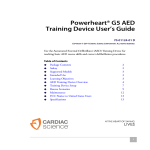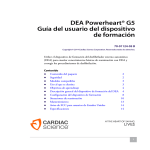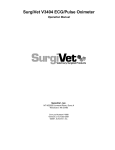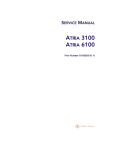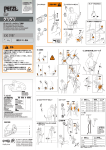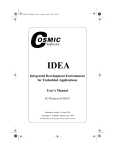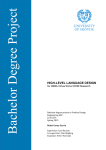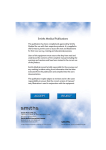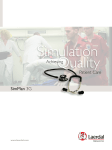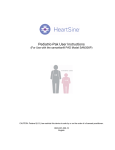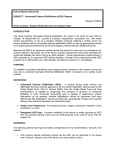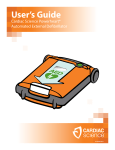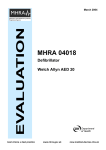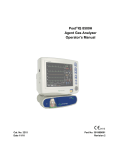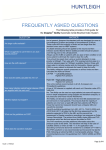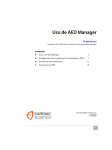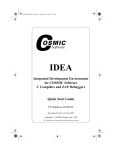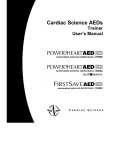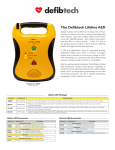Download Powerheart G5 AED Trainer Manual – English UK
Transcript
Powerheart® G5 AED Training Device User’s Guide 70-01124-02 B COPYRIGHT © 2014 CARDIAC SCIENCE CORPORATION. ALL RIGHTS RESERVED. Use the Automated External Defibrillator (AED) Training Device for teaching basic AED rescue skills and correct defibrillation procedures. Table of Contents Package Contents Safety Supported Models Intended Use Learning Objectives AED Training Device Overview Training Device Setup Rescue Scenarios Maintenance FCC Notice to United States Users Specifications 2 2 3 3 3 4 7 9 12 13 13 1 Powerheart® G5 AED Training Device User’s Guide Package Contents In the AED Training Device box, you should find the following: Powerheart® G5 Training Device (1) Three C-cell batteries are required (not included) Adult trainer pads (1 pair) Infra-red remote control (1) Two AAA batteries are required (not included) Language Packs and User’s Guide CD Overlay for an automatic version Language configuration instructions Safety Before using the Training Device, be aware of the following: ! WARNING! Patient injury or death. The AED Training Device is not a rescue device and cannot deliver defibrillation shock therapy. The AED Training Device is for training or demonstration only. To avoid confusion, do not store the AED Training Device or AED Training Pads in the same area with other AED equipment. To avoid confusion when referring to the AED Training Device and other devices in this manual, the following terms are used: 2 Rescue—any device or accessory intended to deliver a therapeutic shock includes the word “rescue” (for example, the Powerheart® G5 Automatic is a rescue AED). Training—any device or accessory used to demonstrate AED functionality includes the words “training” or “Training Device” (for example, AED Training Pads cannot deliver a therapeutic shock). 70-01124-02 B Supported Models Supported Models This AED Training Device approximates the function these Cardiac Science Corporation AED models: Powerheart® G5 Automatic Powerheart® G5 Semi-automatic Additionally, the Training Device supports branded and other models that have the same functionality as the listed models. Intended Use The AED Training Device and this manual are intended for use by qualified instructors with the following competencies and experience: American Heart Association or European Resuscitation Council (or their equivalents) cardio-pulmonary resuscitation (CPR) certification and first responder defibrillation training A thorough understanding of operation and use of supported rescue AED models and accessories For detailed operating instructions for a specific rescue AED model, refer to the User’s Guide for that model. Learning Objectives After training, students should have the minimum competencies: Successfully simulate a patient rescue using the AED Training Device Understand the operation of rescue AEDs Understand differences between the AED Training Device and rescue AEDs 70-01124-02 B 3 Powerheart® G5 AED Training Device User’s Guide AED Training Device Overview The AED Training Device is a simulated AED for teaching basic rescue skills and correct defibrillation procedure to first responders who use Cardiac Science AEDs. The AED Training Device can: Simulate each rescue stage Change rescue scenarios (4 rescue scenarios are available) Create simulated cardiac rescue scenarios, both shockable and non-shockable Instructors operate the AED Training Device by remote control. AED Training Device Parts The AED Training Device has the same general external features as a rescue AED. Note: The AED Training Device uses special training pads only to demonstrate proper pad placement. Training pads cannot deliver a shock or provide feedback. The AED Training Device may be configured for semi-automatic or automatic operation. Refer to the appropriate rescue AED User’s Guide for detailed descriptions of parts of a rescue AED. 4 70-01124-02 B AED Training Device Overview AED Training Device Remote Control Functions The remote control has the following functions: Table 1: AED Training Device Remote Buttons Button 1: • • Press while the trainer prompts, “Shock Advised” to change the prompt to, “Rhythm changed. Shock cancelled.” • Press during Place Pads prompts to forward to the Analysis prompts. The next sequence (Shock or CPR) is determined by the selected scenario. • Press during a CPR sequence to forward to the Analysis prompts, followed by another CPR sequence. • Press during Place Pads prompts to forward to the Analysis prompts. The next sequence (Shock or CPR) is determined by the selected scenario. • Press during a CPR sequence to forward to the Analysis prompts followed by a Shock sequence. • Press during analysis to prompt, “Press pads firmly to patient’s bare chest.” • Press again to continue the scenario. Shock cancelled 2: • Use Shock advised 3: • Check pads After the prompt, “Remove white square package from lid of AED,” press to prompt: • “Peel one of the white pads completely from blue plastic” • “Firmly place the pad on the patient” • “Next, peel second white pad from the blue plastic” 4: • Place pads “Firmly place the second pad on other location.” Note: Press to advance through the prompts more quickly. • 70-01124-02 B 5 Powerheart® G5 AED Training Device User’s Guide Table 1: AED Training Device Remote Buttons (continued) Button Use • Press during Analysis prompts to prompt, “Analysis interrupted. Stop patient motion.” • Press again to continue. • Press during a rescue scenario to prompt, “Battery low” (the battery LEDs will also show low battery). • Press again to turn off the low battery LED and turn on two green battery LEDs. • Press to prompt, “Service required.” • Press again to continue. • Press at any time to pause (the AED Training Device beeps while paused). • Press again to continue. 5: • Analysis interrupted 6: • Battery low 7: • Service required 8: Note: If the device is already in Pause mode because a • Pause • Resume 9: 6 • Change scenario • Change volume scenario sequence finished, the AED Training Device restarts. • Press # then 1 to start Scenario 1. • Press # then 2 to start Scenario 2. • Press # then 3 to start Scenario 3. • Press # then 4 to start Scenario 4. • Press # then 7 to decrease volume. • Press # then 8 to increase volume. 70-01124-02 B Training Device Setup Table 1: AED Training Device Remote Buttons (continued) Button 10: • CPR feedback Use • Press 10 then 1 to prompt, “Press harder.” • Press 10 then 2 to prompt, “Press softer.” • Press 10 then 3 to prompt, “Press faster.” • Press 10 then 4 to prompt, “Press slower.” Note: Turn ON CPRD option on the configuration menu before performing this operation. Training Device Setup The Training Device has several features that can be tailored to the needs of the instructor. Language Selection Note: This is only for devices with dual languages installed. To change the language of the voice and text prompts: 1. Open the Training Device lid and immediately press and hold the Shock button for 5 seconds. The Shock button remains lit and the current language is displayed on the screen. 2. Press the left soft key on the Training Device to scroll through the language selections (default or alternate). 3. When the desired language is displayed, press the Shock button. 70-01124-02 B 7 Powerheart® G5 AED Training Device User’s Guide Operating Mode To set the mode: 1. Select the language. The Training Device displays the current operating mode. 2. Press the left soft key to display the mode selection: Automatic or Semi-automatic. 3. Press the Shock button to select and save the mode. Prompt Level To set the prompt level: 1. Select the operating mode. The Training Device displays the current prompt level. 2. Press the left soft key to scroll through the prompt levels: Basic, Standard, and Advanced. 3. Press the Shock button to select and save the prompt level. CPR Prompt Style To set the CPR prompt: 8 1. Select the prompt level. The Training Device displays the current CPR prompt style. 2. Press the left soft key to scroll through the CPR prompt styles: Traditional 30:2 and Compressions Only. 3. Press the Shock button to select and save the CPR prompt style. 70-01124-02 B Rescue Scenarios Metronome Option 1. Select the CPR prompt style. The Training Device displays the Metronome option. 2. Press the left soft key to scroll through the Metronome option: ON or OFF. Note: If the Prompt Level is set as Basic or Standard and the CPR Prompt style is Compressions Only, the metronome is set to ON. 3. Press the Shock button to select and save the Metronome option. CPR Device Prompt Option 1. Select the Metronome option. The Training Device displays whether or not the CPR Device prompt option is ON or OFF. 2. Press the left soft key to change the CPR Device prompt option. 3. Press the Shock button to select and save the CPR Device prompt option. 4. The Training Device restarts with the new setting. Rescue Scenarios This section describes a typical rescue scenario and then lists the pre-set rescue scenarios. To change scenarios, refer to AED Training Device Remote Control Functions on page 5. Note: Unlike a rescue AED, the AED Training Device does not store rescue information. 70-01124-02 B 9 Powerheart® G5 AED Training Device User’s Guide Typical Rescue Scenario The following steps demonstrate a typical rescue scenario. Once the AED Training Device is set and the lid is opened, the AED Training Device advances through the complete scenario. The instructor may speed up the scenario if required. 1. Open the lid of the AED Training Device. The AED Training Device prompts, “Stay calm and follow these instructions” and ensure that Emergency services are called now. 2. Press 4 on the remote to advance through the pad placement prompts: Note: The prompts below are provided when the Standard Prompt level is selected. • “Tear open white package across dotted line and remove pads”. • “Peel one of the white pads completely from the blue plastic”. • “Firmly place the pads without the blue plastic on patients bare chest exactly as shown on the pads”. • “Next, peel the second white pad from the blue plastic”. • “Firmly place the second pad on the other location exactly as shown on the pads”. 3. Press 4 again to indicate pad placement. 4. The AED Training Device advances to the analysis stage of the rescue sequence and prompts, “Do not touch patient. Analyzing rhythm.” 5. If a shockable rhythm is selected, the AED Training Device prompts, “Shock Advised.” 6. Next, follow these steps to deliver a simulated shock: Note: Following steps are applicable only for Semi-automatic mode. a. The AED Training Device prompts, “Press red flashing button to deliver Shock.” b. The student presses the Shock button to deliver the first simulated defibrillation. 10 70-01124-02 B Rescue Scenarios If the Shock button is not pressed after 30 seconds, the device prompts, “A shock is not delivered,” and enters CPR mode. If the scenario defines a non-shockable rhythm, the AED Training Device prompts, “If needed, perform CPR as instructed.” Recommended Rescue Scenarios Note: If simulating an automatic AED, instead of prompting for shock, the AED Training Device counts down and then automatically delivers a shock. Table 2: Rescue scenarios Step Scenario 1 Scenario 2 Scenario 3 1 Open the Training Device lid 2 Place pads on manikin 3 The Training Device performs analysis Scenario 4 4 Prompt to shock (Semi-Auto) or shock delivered (Auto) Prompt to shock (Semi-Auto) or shock delivered (Auto) Prompt to shock (Semi-Auto) or shock delivered (Auto) No shock advised 5 CPR CPR CPR CPR 6 Analysis Analysis Analysis Analysis 7 No shock advised No shock advised Prompt to shock (Semi-Auto) or shock delivered (Auto) No shock advised 8 CPR CPR CPR CPR 9 Analysis Analysis Analysis Analysis 70-01124-02 B 11 Powerheart® G5 AED Training Device User’s Guide Table 2: Rescue scenarios (continued) Step Scenario 1 Scenario 2 Scenario 3 Scenario 4 10 No shock advised Prompt to shock (Semi-Auto) or shock delivered (Auto) Prompt to shock (Semi-Auto) or shock delivered (Auto) No shock advised 11 CPR CPR CPR CPR 12 Analysis Analysis Analysis Analysis 13 No shock advised No shock advised Prompt to shock (Semi-Auto) or shock delivered (Auto) No shock advised 14 CPR CPR CPR CPR Maintenance The AED Training Device has no user-serviceable parts. The only maintenance required is to: Clean external surfaces with a damp cloth. Replace batteries in the AED Training Device or remote as needed. • The AED Training Device requires three C-cell alkaline batteries • The remote control requires two AAA alkaline batteries When replacing batteries, ensure that the polarity is correct. For any other maintenance or repair problem, call Cardiac Science Technical Support, or outside the United States, your local representative. 12 70-01124-02 B FCC Notice to United States Users FCC Notice to United States Users This device complies with part 15 of the FCC rules. Operation is subject to the following two conditions: (1)This device may not cause harmful interference, and (2) This device must accept any interference received, including interference that may cause undesired operation. See 47CFR Sec. 15.19(3). Specifications The following table lists AED Training Device specifications: Table 3: Specifications Parameter Detail Dimensions Height: 8 cm (3.3 in) Width: 24 cm (9.5 in) Depth: 32 cm (12.5 in) Operating and Standby Conditions Temperature: 0° C to +50° C (32° F to +122° F) Shipment Conditions (Up to one week) Temperature: -40° C to +65° C (-40° F to +149° F) Battery AED Training Device: Three C-cell alkaline batteries Humidity: 5% to 95% (non-condensing) Humidity: 5% to 95% (non-condensing) Remote control: Two AAA alkaline batteries Emissions Radiated E-M: EN 55011, Group 1, Category B with Radio-frequency: CISPR 11, Class B, Group 1 Immunity Radiated E-M: EN 61000-4-3 Radiated M: EN 61000-4-8 ESD: EN 61000-4-2 70-01124-02 B 13 Cardiac Science Corporation • N7 W22025 Johnson Drive, Waukesha, WI53186-1856 USA • +1.262.953.3500 • US toll-free +1.800.426.0337 • Fax: +1.262.953.3499 • Email: [email protected] Orders and Customer Care (US and International) • +1.262.953.3500 • US toll-free +1.800.426.0337 • Fax: +1.262.798.8292 • [email protected] Technical Support • (US) toll-free +1.800.426.0337 • Fax: +1.262.798.5236 • [email protected] • (International) [email protected] Cardiac Science, the Shielded Heart logo, Powerheart, and Rescue Ready are trademarks of Cardiac Science Corporation. Copyright © 2014Cardiac Science Corporation. All Rights Reserved. 14 70-01124-02














